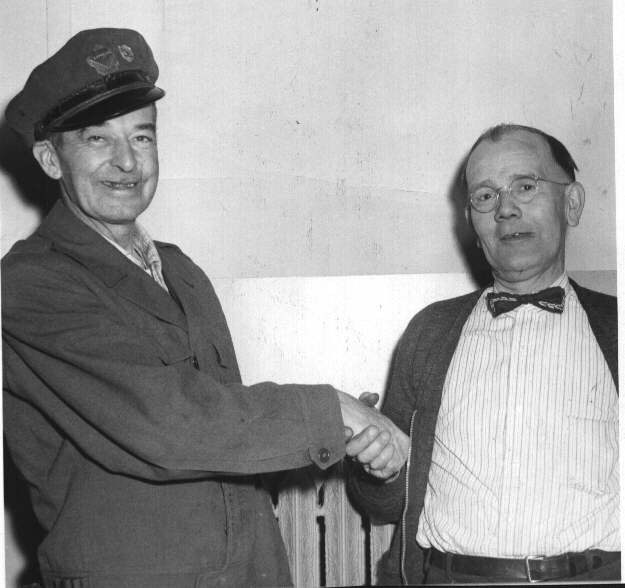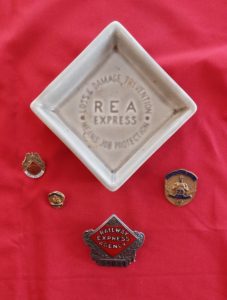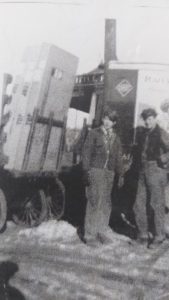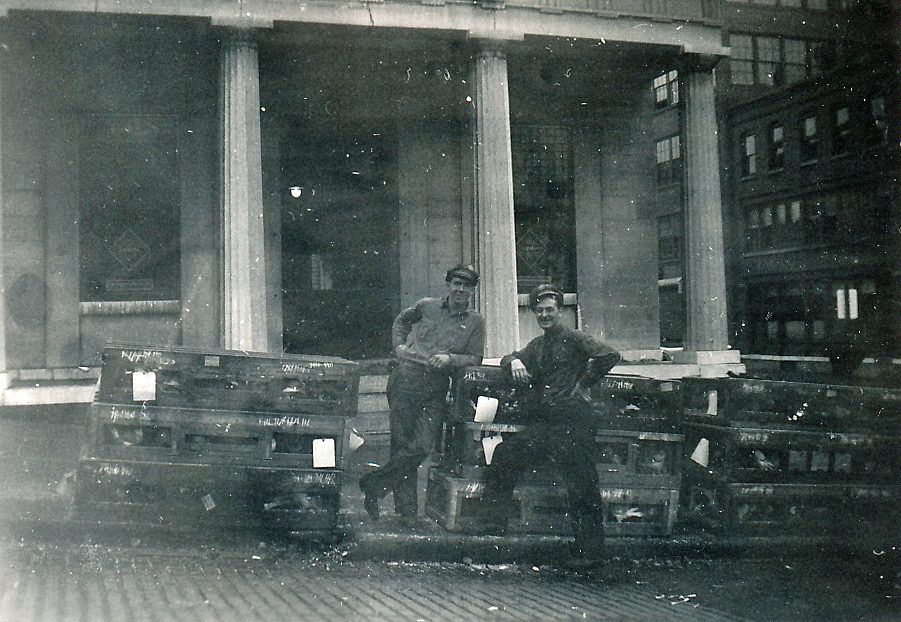The Railway Express Agency and Pigeon Releasing
By Jeffrey Gressler, Little Falls Historical Society.
Sometimes all it takes is a picture or a story to generate a Historical Society writing series piece. Such is the case with this article. This effort began when relatives exchanged family pictures, one of which captured Railway Express Agency employees Jimmy Fitzgerald and Al Munger standing in front of what was then the Railway Express Agency’s office after unloading crates of homing pigeons. The crates of pigeons in turn unlocked decades-old memories of homing pigeons being released outside Vets Park on Burwell Street in the late-1950s and early-1960s.
Let’s begin with some background information about the building in the picture that now houses the Little Falls Historical Society’s Old Bank Building Museum. Further along, we can talk about a parrot, a chimpanzee, and those homing pigeons.
OLD BANK BUILDING MUSEUM PAST USES
There are two buildings in the “pigeon crates” picture, the Old Bank Building Museum on the left, and the long since demolished multi-storied Cherry Burrell plant building on the right.
The Old Bank Building was constructed of cut native stone and dressed limestone; the Herkimer County Bank began operation in the new structure in 1833. In 1917, the bank moved up the street to the new Burrell Building, and from 1917-18 (World War I), the Old Bank Building was used as a Red Cross facility. From 1918-22, the building housed the Little Falls National Bank which had to be relocated due to a fire in the Cronkhite Building at the southwest corner of the Main Street and Ann Street intersection. The building next housed Dinneen’s Mortuary Parlor between 1923 and 1928, and from 1928 to the mid-1950s, the Old Bank Building was the local office of the Railway Express Agency (REA). The ‘pigeon crates’ picture was most likely taken in the late-1940s. Until 1964, the Old Bank Building was used as a storage facility for Lovenheim’s.
The City of Little Falls Urban Renewal Agency purchased the building from Lovenheim’s in 1964. In 1970, the building was placed on the National Register of Historic Places, upsetting some officials in city government. A small group of backwards looking obstructionists were seen as blocking progress. Or maybe, those people were visionary historic preservationists ahead of their time trying to preserve a community treasure? The Little Falls Historical Society purchased the Old Bank Building in 1977, and, from 1978 through 1985, extensive building restoration was undertaken. The museum opened to the public in 1985. The rest is history, play on words intended!
RAILWAY EXPRESS AGENCY
Just as UPS, Fed Ex, and Amazon Prime trucks crisscross our streets today delivering packages to our doorsteps, REA once served that function and purpose. The primary difference was that REA packages were unloaded from New York Central rail lines, moved up the street to the Old Bank Building and into the REA office where they were sorted by driver delivery routes and then reloaded into the dark green trucks with red trim for home and commercial delivery. The Railway Express Agency Company existed from 1918-1975. In its time, REA was the nation’s premier package carrier. The company also used coordinated services with selected airlines and was able to guarantee next-day delivery for the right price.
COMPANY ORIGINS, GROWTH, DECLINE, AND FINALLY, BANKRUPTCY
America’s entry into World War I spotlighted the need for a better organized nationwide service to ensure the safe delivery of parcels, money, and packages for wartime purposes. The federal government forced a number of regional package delivery companies to consolidate into the American Railway Express ensuring the rapid delivery of essential materials during World War I. In effect, the government created a monopoly. More company changes followed.
In 1929, a consortium of sixty-nine railroads bought REA. The company was very profitable through the 1950s, but highway tractor trailers and other vehicles gradually became the preferred means of package delivery by the 1960s. REA refrigerated train cars continued to provide profitability, but once tractor trailers could be refrigerated, the whole business model of package delivery by railroads became obsolete. The Railway Express Agency held on until 1975 and then went into bankruptcy, unable to adapt to modern modes of package delivery.

Jimmy Fitzgerald receiving his safe driving award from Godfrey Palmer after 37 years of service. Photo courtesy of the Little Falls Historical Society.
THE TYPICAL DAY OF AN REA DELIVERY MAN

Family keepsakes of Jimmy Fitzgerald’s family – small ceramic tray with hat badge in front and flanked left and right by safe driving pins. Photo courtesy of the Little Falls Historical Society.
Jimmy Fitzgerald worked for the Railway Epress Agency Co., retiring in 1967 after thirty-seven years of service, mostly as a delivery truck driver. His primary delivery route was in Dolgeville. Both of Jimmy’s and wife Anne’s children, Jim and Nan, remember their father as a contented employee who loved his job and did it well; Jimmy’s safe driving award presentation picture and multiple safe driving pins that were held as family keepsakes for decades speak to this fact.
Another of Jimmy’s and other REA employees’ job assignments was loading boxes of Snyder’s bicycles onto New York Central rail cars for shipment throughout the country.
One of REA’s “calling cards” was its capacity to deliver live animals; a couple of humorous stories recalled by Jim and Nan are now called for. One hot summer day found their father delivering a package in Little Falls and knocking on a screen door. An inside voice called out: “Get out of here, what are you doing around here?” Jimmy answered: “I’m the express delivery man.” The inside voice then repeated: “Get out of here, what are you doing around here” and added: “I’m the express man.” Jimmy then realized that he was not speaking to a person, but rather, to a quick-learning, rather intelligent parrot!
Another humorous old story finds Jimmy delivering a caged chimpanzee that had arrived by train to Daly’s Game Farm, once located off Kelly Road about midway between Little Falls and Middleville. Enroute, the chimpanzee reached through its cage and grabbed Jimmy’s arm, almost pulling him out of his driver’s seat and possibly into a highway accident. A descendent of the Daly family recently recalled that “the chimpanzee was really strong.” So much for the parrot and the chimpanzee, now onto the homing pigeons.
HOMING PIGEON RACING
A BRIEF HISTORY

Employees Jimmy Fitzgerald (on right) and Al Munger loading Snyder’s bicycles onto railroad carts outside Little Falls train depot building. Photo courtesy of the Little Falls Historical Society.
Competition results from the first Olympic games in 776 BC Greece were relayed via carrier pigeons throughout the Greek states. More structured homing pigeon raising and racing began in the early-1800s in both England and Belgium. News of Napolean’s 1815 defeat at Waterloo arrived in England via carrier pigeon.
In the 1860s, homing pigeons were first brought to America from Europe, and by the 1880s, homing pigeon clubs had been formed, pigeon racing and betting on race outcomes soon followed. The United States Army Signal Corps used homing pigeons in combat settings by the early 1900s.
The training of homing pigeons is an arduous undertaking, involving selective crossbreeding and training for maximum flight speed and distance in competitive, directed flights over carefully measured distances. Typical race distances are between 100 and 600 miles with 300 miles being a popular distance. Flight speed can reach 90 MPH. Repeated practice training is the key to successful pigeon racing results.
Homing pigeon race competitions begin with the coordinated release of birds from trap doors. Upon release, the pigeons rapidly ascend, orient themselves, and then begin the long flight home. Gambling on race outcomes by individuals and clubs was once commonplace.
WITNESSING THE RELEASE OF THOUSANDS OF HOMING PIGEONS
Unfortunately, no pictures or newspaper articles could be located of the 1950s-60s Burwell Street homing pigeon releases. We must rely on the aging eyewitness memories of neighborhood “youngsters.” Rocco Scarano, others who wish not to be identified, and this author, all agree on the following narrative. The pigeon releases took place on weekend mornings from the backs of large trucks stacked high with two or three tiers of caged pigeons. No one can recall any particulars regarding who was doing the releasing or where the pigeons might be “returning home” to.
One can recall the Loomis and Burwell Streets neighborhood excitement when word went out that “pigeon trucks were at the ballfield.” People, particularly kids, would flock towards the large parking lot to excitedly await the timed releases by pigeon handlers. One is left wondering about the details of how the pigeon crates arrived by truck. Were they transported via train, transferred to locally owned trucks or were trucks loaded with crated pigeons driven to Little Falls from departure points unknown? Jim Fitzgerald also recalls that his father and Al Munger were responsible for timed pigeon releases from in front of the REA office itself.
Were the crated pigeons in the picture about to be released by Jimmy and Al, or were they about to be loaded onto trucks and driven up to Burwell Street for timed releases?
However the pigeons arrived at the ballfield parking lot, anticipation and excitement ran high, both for birds and spectators. One can recall handlers checking their watches, presumably in coordination with race timers on the other end. As handlers began sequential crate openings and pigeon releases, cooing and grunting intensified. The pigeons “were ready to race.” Upon release, the flocks of birds would quickly gain altitude, circle to get their bearings and then begin heading off to destinations unknown. Remember, races often took place over distances of three hundred miles or more.
Circling back to our point of beginning, special thanks is given to Jim Fitzgerald and Nan (Fitzgerald) Mosher both for providing the pictures that accompany this admittedly quirky article and for authorship assistance. The combination of Old Bank Building Museum loyalty, family ties and childhood memories motivated its writing.
As a side note, Anne Fitzgerald was a longtime, much-beloved Benton Hall Elementary School kindergarten teacher.
Cousins Jeffrey Gressler, Jim Fitzgerald, and Nan (Fitzgerald) Mosher are all members of the Little Falls Historical Society.


 Fenimore Art Museum, Cooperstown, NY. Photo Courtesy of the Fenimore Art Museum.
Fenimore Art Museum, Cooperstown, NY. Photo Courtesy of the Fenimore Art Museum.